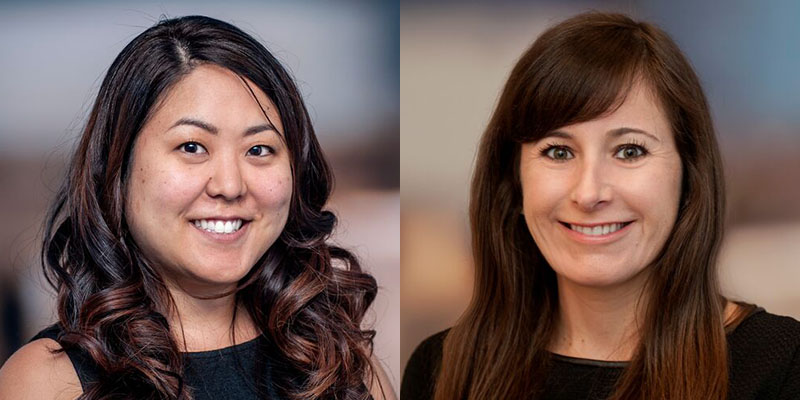Neurocutaneous Syndromes: A Q&A With Drs. Stephanie Randle and Aimee Sato
 Dr. Aimee Sato (left) and Dr. Stephanie Randle
Dr. Aimee Sato (left) and Dr. Stephanie Randle
Drs. Randle and Sato will be presenting a one-hour category II CME on March 19 at 6 p.m., Neurocutaneous Syndromes: What Primary Care Providers Need to Know. Learn more and register.
Neurocutaneous syndromes are disorders that affect the brain, spinal cord, organs, skin and bones. The diseases are lifelong conditions that can cause tumors to grow in these areas. They can also cause other problems such as hearing loss, seizures, and developmental problems. Two of the most common types of neurocutaneous syndromes are tuberous sclerosis complex (TSC) and neurofibromatosis (NF).
Q: What are tuberous sclerosis complex and neurofibromatosis?
Stephanie Randle, MD, MS, Director, Tuberous Sclerosis Complex Program: TSC affects about one in 6000. Most of patients get identified either prenatally or in infancy. During pregnancy, a fetal echocardiogram may detect cardiac tumors and then the patient gets referred to us after they've been born. Sometimes we do prenatal counseling. If a pediatrician hears a heart murmur in an infant, the patient often will get an echocardiogram, and that could reveal the tumors in the heart. Other times, kids get referred to us if they present with seizures, which usually occurs in infancy.
Aimee Sato, MD, Director, Neurofibromatosis Program: Neurofibromatosis is kind of an umbrella term. Neurofibromatosis type 1 (NF1) is the most common. It affects about one in 3000, and complications arise during childhood. Neurofibromatosis type 2 is a completely different condition, and we do have some patients with that. That affects about one in 25,000, and manifestations can happen in childhood but usually start in adolescence. And there's also schwannomatosis, and that affects one in 40,000 and presents during adulthood, so we don't have a lot of patients.
Typically, when people are talking about someone who has neurofibromatosis at Seattle Children's, we’re usually referring to someone who has NF1.
Q: What are the complications of these disorders?
Dr. Randle: TSC is a lifelong genetic disorder. Most patients have neurologic complications like infantile spasms, which can be catastrophic, brain tumors or epilepsy. Patients may also have eye, cardiac or renal complications. Most have skin birthmarks or dermatologic findings. Children may also experience autism, anxiety or depression.
Dr. Sato: NF1 is a genetic condition that's affecting the NF 1 gene, and it can cause many different complications to occur. Typically, the most common are tumors or neurofibromas. It's the type of tumor that can develop anywhere.
About a quarter of our patients with NF1 will have a brain tumor. Other complications are headaches, learning challenges, developmental challenges or behavioral issues. There's also increased risk of autism as well, and so from a mood and behavioral perspective and learning, there are a lot of other manifestations.
There are also potential for other things like hypertension, constipation or pain, so it can really have a lot of different manifestations from head to toe.
A lot of families would say they start noticing symptoms in the first couple of years of a kid’s life, but they may become more prominent and more noticeable kind of throughout childhood.
Q: What should providers look for and when should they refer a patient?
Dr. Randle: In addition to infantile spasms, babies may present with birthmarks. Two of the most common are hypomelanic macules (ash leaf spots) that are white and may appear anywhere on the body or a shagreen patch on the lower back or nape of the neck that has an orange peel-like texture. Seattle Children’s also offers clinical trials for TSC, so that’s a good reason to refer a baby early.
Dr. Sato: One of the ways that people have been classically diagnosed with NF1 is that they could have some skin findings called cafe au lait spots. While some can be present at birth, a lot of these kinds of dark spots can appear over time as the child gets older.
Brain tumors usually affect children with NF1 very early, age 4 on average. That's why it's really important for us to be able to see children early. I think it’s important for a pediatrician to be looking for findings such as cafe au lait spots and then making an .
Q: What can Seattle Children’s offer these patients?
Dr. Randle: Seattle Children’s has the only Center of Excellence for TSC in the Northwest. I have worked to build a program that helps care for patients with TSC for all of their medical needs, not just their neurologic needs. We have a dedicated team including physicians, advanced practice providers, schedulers, clinical coordinators, and nurses with in-depth knowledge to support patients with TSC.
Dr. Sato: There’s a lot more research and actual advancements that have been done for patients with NF1. At Seattle Children’s, we have rehabilitation clinics, genetics clinics, and brain tumor clinics where we are more proactive in diagnosing and managing the complications.
We also have medical treatments now as well. Most recently, the FDA approved a medication for the treatment of particular tumors for our kids with NF1.